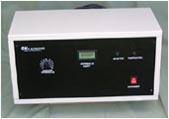|
Ultrasound Technology
 Ultrasonic
cleaning is brought about by high frequency sound waves introduced
into the cleaning fluid. This action, known as cavitation, consists
of the formation and immediate collapse of millions of minute
bubbles in the liquid. These bubbles move through the solution
reaching hidden interstices and grooves, and upon implosion, drag
out the grime. Ultrasonic
cleaning is brought about by high frequency sound waves introduced
into the cleaning fluid. This action, known as cavitation, consists
of the formation and immediate collapse of millions of minute
bubbles in the liquid. These bubbles move through the solution
reaching hidden interstices and grooves, and upon implosion, drag
out the grime.
The electronic unit, the generator, possesses an alternative frequency
system which allows cavitational uniformity, not allowing stationary
waves to be established in the cleaning tank; thus improving cleaning
quality, durability of the transmission devices, transducers,
and life span of the whole system.
This technology allows a greater and deeper penetration regardless
the water level, better propagation of the power of the bath and
uniformity of the ultrasonic energy. |
| |
Generator Comparison Table |
|
|
CMR Generators |
Frequency
control |
Auto-oscillating |
Predetermined
by control |
|
Frequency
sweep |
Absent |
Present |
|
Amplitude
modulation |
Not
possible |
Optional |
|
Power
control |
Absent |
Present |
|
Progressive
shutdown mechanism
in case of overheating |
Absent |
Present |
|
Over electric current protection |
Absent |
Optional |
|
Line
filter |
Absent |
Present |
|
Sincro
Link |
Not
possible |
Optional |
|
Red
Serie Control |
Absent |
Optional
(RS232 ó RS485) |
|
Technology |
Transformer |
Solid
state |
|
Weight |
16
Kg. |
4
Kg. |
|
Approximate
size |
500x400x220 |
330x220x160 |
|
|
| |
Spray Technology
Basically, this technology
is based on the use of water at high pressure that is aimed at the
areas that need to be cleaned.
It implies a detailed inspection of the parts to be cleaned, the
type of production and the time. This determines the number and
type of sprinklers and also the power and flow capacity of the pump. |
| |
|
|